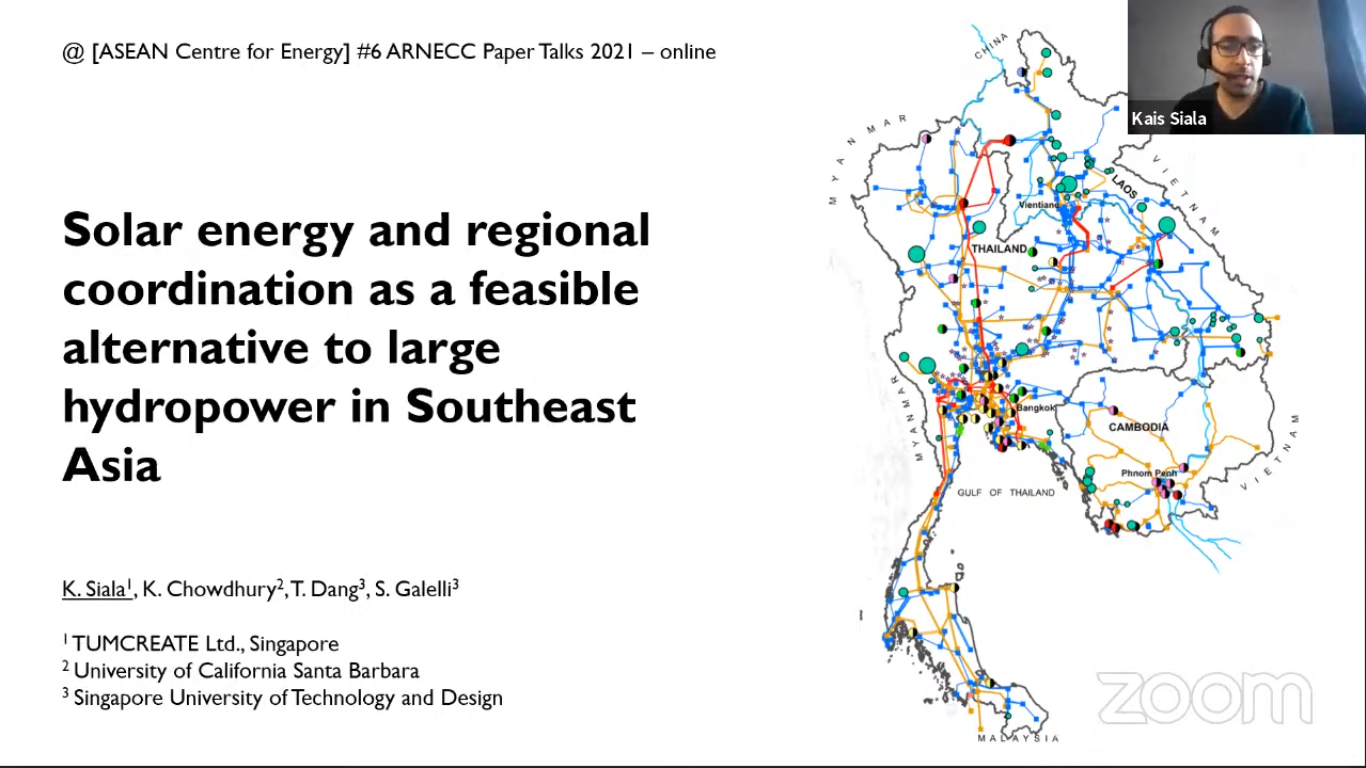Jakarta, 26 August 2021
ASEAN Climate Change and Energy Project (ACCEPT) held the sixth ARNECC Paper Talks on 26 August 2021 with main topic “Solar Energy and Regional Coordination as a Feasible Alternative to Large Hydropower in Southeast Asia”, recently published in Nature Communication. The topic is close to energy cooperation in ASEAN region and also related to the power grid in the Mekong area. Authors are Dr. Kais Siala (Research Assistant (Postdoc) at Potsdam Institute for Climate Impact Research), Dr. Afm Kamal Chowdhury), Dr. Thanh Duc Dang, and Dr. Stefano Galelli, in which Dr. Siala as the lead author share the key findings of the study. The event was hosted by ACCEPT Research Analyst, Ms. Monika Merdekawati.

The paper explores the energy pathways for the Mekong region, particularly for Cambodia, Laos, and Thailand. The total capacity of all of the region is about 42 GW and another 22 GW is planned for the next decades. The study modelled the expansion plan of hydropower system from 2020 to 2037. The result of model is the optimisation of power mix in the Mekong countries where the installation of gas power plant is still needed to support the growing electricity demands and the large potential of solar PV.
Based on the main objective to optimise the operations of hydropower that take into account climate change, then the three research questions are explored: 1) is it possible to design more sustainable energy plans for the lower Mekong Region, 2) can we limit the number of dams that will be built in the near future, 3) what are the main technologies and policies that should be prioritized?
Experimental setup of this model is the capacity expansion of period 2016-2037 that includes dam development portfolios (Reference, Stop-Stem, Stop-All, Stop-Planned). The “Energy mix – reference” of 2016-2037 shows decreasing share of gas and coal and increasing share of renewable: solar PV (68.2 GW by 2037) and hydro (9.3 GW to 22.8 GW in 2037). That corresponds to 82% execution rate of planned cost optimization.
The “Energy mix-alternative dam portfolio” touches on the subject of River Fragment Index (RFI – impact on natural connectivity of riverine systems) and River Regulation Index (RRI – impact on the natural flow regime). From that point of view, the expansion of dams directly correlates with the lowest RFI. In other words, the need of hydroelectric should be decreased and could be substituted by solar PV and gas. Not all planned dams are necessarily be built. Alternative pathways are economically and technically feasible with the support of key enabling strategies such as solar PV and cross-border power trading, and alternations of the natural flow regime depends primarily on dams built in the Upper Mekong.
The panel discussion begins with Mr. Aloysius Damar Pranadi (Policy Associate at Castlerock Consulting) discussing Dr. Siala’s paper and commenting about the fact that, all-planned dams must not necessarily be built with respect to biodiversity issues of hydropower systems. He recommended interconnection and border power sharing in each Mekong countries depending on their own perspectives. He also discussed optimization and the challenges for data collection to do regional cooperation in power system planning.
Dr. Siala responded to Mr. Pranadi’s discussion by explaining that the use of hydropower systems may not be efficient for energy demand of future Mekong based on the “Energy mix-alternative dam portfolio”. So that there is a need to avoid building too many hydropower dams for the future. There is also discussion about the ratio of solar capacity distribution, hydro capacity distribution, power demand distribution, residual demand distribution, and added grid capacity for high demand regions, especially Bangkok, in 2037.
Mr. Pitoon Junthip (PhD candidate at University of Flensburg) also remarked the consequence of depending too much on gas power in Thailand may not be sustainable for more than five years as it may drive the energy price significantly. And the cost impact is significant if to use more gas to provide power system reliability.
In the perspective of solar PV development, it is quite necessary to understand the different context of the countries. And the balance of all dimensions between economic and environmental impact and social perspective is equally important in the energy planning. Dr. Siala responded to feedback of Mr. Junthip by clarifying that the study is not promoting gas. But for ASEAN, if there is a high decarbonisation target, coal and gas should be subverted in place of solar and hydro.
As a conclusion, Ms. Merdekawati, Mr. Pranadi, and a guest attendee discussed their thoughts on implementation of floating Solar PV technology and rooftop solar PV technology in the perspective of cost acquisition and land acquisition compared to other ASEAN countries. One attendee also commented on the co-benefit of floating solar PV such as reducing evaporation. After the dialogue, a mutual decision was reached by all panelists for overcoming the environmental impacts of the energy sector in Southeast Asia.
Access the Paper at https://www.nature.com/articles/s41467-021-24437-6
Read more reportage
(AKH).